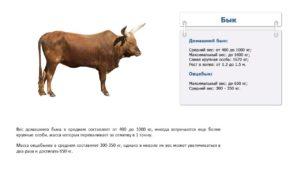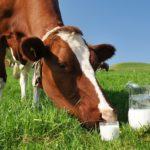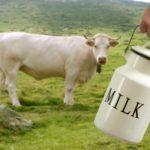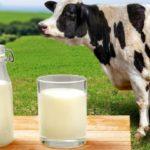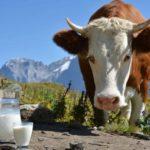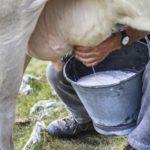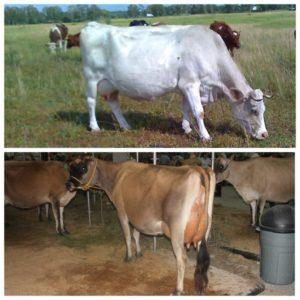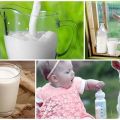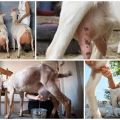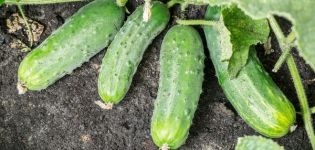What ways can you increase milk yield in a cow at home?
Everyone who keeps a cow would like her to give a lot of milk. After all, it depends on whether its content will be cost-effective and profitable. Let us consider how you can increase the milk yield of a cow at home through rational feeding, caring for the animal, creating optimal living conditions, taking care of health and proper milking.
Content
- 1 What and how to feed
- 2 Correct start and break
- 3 Attitude towards the cow
- 4 Consuming large amounts of water
- 5 Probiotic use
- 6 Compliance with the milking schedule
- 7 Calving season planning
- 8 Competent milking technique
- 9 Udder hygiene
- 10 Increased daylight hours
- 11 Fresh air intake
- 12 Correct grazing
- 13 Maintaining temperature conditions
- 14 Regular health monitoring
What and how to feed
The foods that will be eaten by a cow affect the composition, taste, fat content and mineral content of milked milk. Despite the fact that cows are herbivores, they cannot produce much milk on grass and hay alone. As a top dressing, they need grain and grain waste, bagasse, meal, cake and molasses - sources of carbohydrates and protein, vegetables and root crops - sources of vitamins and minerals. And also chalk, salt and fodder sulfur, meat and bone meal and milk powder as mineral additives.
In the diet of domestic cattle, not only variety is important, but also the ratio of roughage and succulent feed and concentrates. In order not to make up the diet yourself, you can feed the cows with compound feed. It has an optimal composition, all components and their proportions are selected so that the product will bring maximum benefits to animals. The frequency of feeding is 3 times a day, the same number of times you need to milk. The distribution of food should be timed to coincide with certain hours, so that the cow gets used to it, and her digestion is activated by this moment.
Correct start and break
Start-up is a gradual reduction in milk production before calving. It is necessary for the animal to have time to recuperate and prepare for feeding the next calf. Pregnant cows are prepared for childbirth by stopping milking a month before the event.
After calving, you need to feed the cow a little more feed than usual. The first week after giving birth, the cow gives only colostrum, which the calf drinks. It can be kept close to the mother. When the milk begins to flow, the animal needs to be milked 5-6 times a day, at equal intervals. Do udder massage before milking. Milk quickly and vigorously, milking all the milk from the udder so that it does not stagnate.
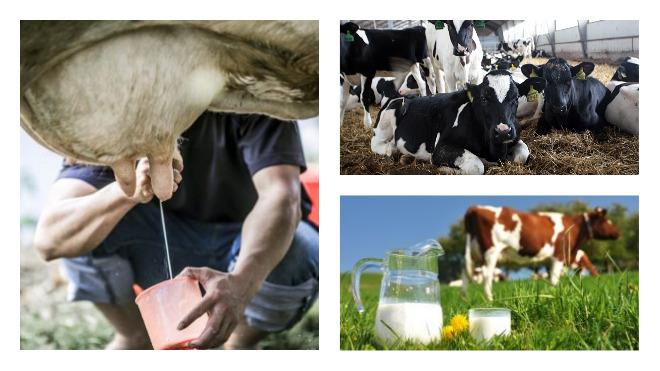
Attitude towards the cow
Aggressive attitude towards the cow, screaming and beating are not allowed. The animal perfectly feels the mood of a person, being in stress, can resist milking, and quickly reduce milk yield. Conversely, in a good mood, the cow will allow milk to be completely milked from the udder. It will not hurt to talk to her before milking, stroke her, give something tasty.
Consuming large amounts of water
In addition to feed, cattle need water. Liquid is the basis of milk, if it is not enough, you should not expect large milk yield. A cow needs to drink 100-150 liters of water per day, 4-6 liters are required to produce 1 liter of milk. The liquid should be warm in winter and cool in summer, always clean and fresh.
Probiotic use
Probiotics contribute to normal stomach and intestinal function. These drugs are given to normalize and improve the microflora of cattle. They stimulate metabolic processes, enhance the efficiency of the use of nutrients from food by the cow's body, and strengthen the immune system.
Compliance with the milking schedule
Milk is constantly produced in cows, therefore, the milking regime affects the productivity of the animal. Cattle are milked at least 2 times a day, usually in the morning and in the evening, you can milk 3 times (recently calved and very dairy individuals). It is possible to increase milk yield only by adhering to the milking regimen.
Calving season planning
Animals that calve in the winter give 7-10% more milk than those that gave birth in spring, summer and autumn. Timed calf birth to coincide with the winter months can naturally increase milk yield.
Competent milking technique
It has already been said that you need to milk all the milk from the udder. The milking machine copes well with this task, which removes milk from all 4 lobes at once. If the device is not available, the front and back quarters should be milked by hand until the milk stops flowing.

Udder hygiene
Before milking, the udder must be washed with warm water and wiped with a cloth. Then a light massage is done, after the end of the procedure, the nipples are wiped off. If the udder skin is damaged, abraded, cracked or dry, it is lubricated with a special cream.
You can buy it at veterinary pharmacies. Creams work quickly and effectively, do not contain harmful substances.
Increased daylight hours
For animals during lactation, it is necessary to maintain the duration of lighting at 16 hours. Artificial lighting in autumn and winter slows down the secretion of melatonin and thereby increases milk yield by 8%. If the windows do not cope with providing light comfort, artificial light lamps should be used. Of course, you will need to spend money on electricity, but this will pay off in an increase in milk yield.
Fresh air intake
The cleanliness of the air that animals breathe is also important. Whenever possible, they should be released outside, even in winter, if there is no frost. When the animals are in the barn, it should be ventilated every day.
Correct grazing
With grazing, the cows go out to the pasture every day. The distance to it should not exceed 2-3 km. Animals need to be moved to a new place 2-3 times a day so that they can eat. The total grazing time is 8-10 hours.
With proper organization of grazing in the summer, yields increase by a third.
Maintaining temperature conditions
Being in a cold room, cattle spend a lot of energy on heating. The temperature in the barn in winter should not drop below 10 ° C. Drafts are excluded, which harm animals even more than cold. In summer, the barn should be cool, no higher than 25 ° C. This is achieved by using a ventilation system or ventilation.

Regular health monitoring
The reasons for the decrease in milk yield can be diseases: mastitis, paresis, cracks in the skin of the udder, pathology of the gastrointestinal tract. It can be difficult to restore health to an animal, and the treatment process will take a long time.To prevent this from happening, you need to observe the animal, conduct veterinary examinations, and vaccinate. A caring attitude to livestock will allow timely detection of a violation or disease and start treatment.
A reduction in milk yield can also occur due to such a defect as self-milk in cows... To eliminate a bad habit, a special device is put on the animal's face, which prevents it from drinking milk, but does not interfere with the absorption of feed.
Increasing the yield of livestock at home is an achievable goal. There are many ways to stimulate milk production. This is the right feeding, the organization of optimal living conditions, grazing in the pasture, the right milking, health protection. A good owner who takes care of his animals has no problem with the amount of milk he receives.
